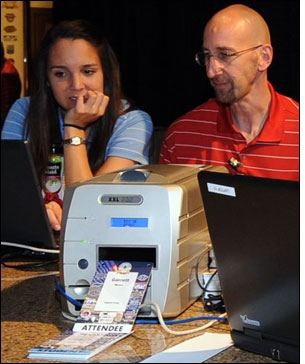Oct 27, 2010Populous, a global firm that helps design stadiums and execute events, has adopted a game plan to incorporate passive EPC RFID inlays into event tickets, passes and credentials, so that its clients can benefit from the use of radio frequency identification. In its first effort related to that mission, the company provided RFID-enabled credentials to the 2,000 attendees of the National Association of Collegiate Directors of Athletics (NACDA) conference in June of this year, at California's Anaheim Convention Center. Populous now plans to incorporate the technology into tickets issued for future sporting events.
"This is something we are trying to advance," says Jeanette Johnson, Populous' event manager and senior associate, explaining why the company opted to initially investigate RFID's use for its ticketing and credentialing operations. "We know RFID is the future, and we're just excited about it," she states. Visibility into the flow of attendee traffic, the ability to authenticate tickets or credentials and the ability to leverage the tags for ancillary applications—such as making purchases—are among the chief benefits that the company hopes RFID will deliver to its clients.

A credential, Johnson explains, is something generally issued to a multiday event or meeting, such as a badge, pass or identification card. A ticket, on the other hand, would generally not include the holder's name, and is typically issued for a sports game or other single-day event. Increasingly, RFID technology is being used in both tickets and credentials.
In 2005, for example, RFID was utilized to authenticate tickets carried by spectators at the Tennis Master Cup in Shanghai (see RFID Takes a Swing at Ticket Fraud). A growing number of conference organizers are experimenting with embedding RFID tags into credentials for applications similar to the NACDA conference, and the Massachusetts Institute of Technology's MIT Media Lab is launching a system by which visitors use RFID tags in their credentials to collect information, as well as learn more about projects being carried out by its researchers (see MIT Media Lab Launches Virtual RFID-Powered Blackboard).
What's more, major sports venues, including Dolphin Stadium (now known as Sun Life Stadium), have built RFID technology into their IT infrastructure (see Dolphin Stadium Kicks Off a Technology Revolution). The stadium, which Populous helped to design, was the site of the 2010 Super Bowl, and the NFL organizers of that event also hired the firm to provide a number of services, including stadium remodeling and operations planning and management.
To develop its RFID offering, Populous partnered with Plastic Printing Professionals (P3), a manufacturer of plastic biometric ID cards, RFID inlays, plastic watermarks and patented optical features that deter counterfeiters. P3 is based in San Francisco, where it produces plastic cards with embedded RFID tags using an in-house assembly and laminating process. This sets the firm apart from plastic-card providers that outsource the RFID inlay layer and then merely laminate that layer between a top and bottom sheet, says Jaeson Caulley, P3's senior sales associate. "One benefit of creating our own cards in-house," he explains, "is lower cost—it's cheaper and faster for us to turn around orders after we receive them."
According to Caulley, P3 makes only plastic media—but if, in the future, Populous opts to issue paper tickets with embedded RFID inlays, P3's parent company, Document Security Systems, could accommodate such a job. P3 and Populous have joined into an exclusive manufacturing and distribution agreement, through which P3 will supply Populous with plastic cards of various shapes and sizes that it has embedded with RFID inlays.
Alien Technology partnered with P3 to develop the RFID-enabled cards for the NACDA conference, Caulley says. In 2006, P3 first began working with Quatrotec, an Alien subsidiary, to conduct early research and development on an RFID-enabled version of P3 plastic credential products. More recently, P3 and Alien have worked closely together to design and test the finished RFID-enabled card products that P3 manufactures.
P3 embedded Alien's Gen 2 RFID inlay with its Higgs-3 integrated circuit into the passes that Populous issued to attendees at the NACDA conference. Each visitor was provided with his or her pre-printed show pass upon arriving at the event—or, if the attendee registered on-site, a pass was printed and encoded on the spot, and presented to that individual.
During the NACDA conference, Johnson reports, Alien RFID readers mounted around each doorway into the exhibit hall collected the RFID tag data, along with a time stamp, as each attendee walked into or out of the hall. Armed with this data, she explains, NACDA could analyze attendees' movement into and out of the hall, and could also use that information to ensure that food and beverage service was adequate for the number of visitors within that location. It could also choose to share the data with sponsors inside the hall, so that they could determine the best times for attendee interaction.
"We saw that most people [at the 2010 conference] were turning to the right when they walked into the exhibit hall," says Bob Vecchione, NACDA's deputy executive director. "So after collecting this data for a few years, we might be able to charge sponsors differently, based on where traffic goes."
To that end, Vecchione says, NACDA plans to again hire Populous to issue the RFID-enabled credentials at its upcoming 2011 conference, in Orlando, Fla., and the organization hopes to add additional readers to the exhibit space in order to collect more granular data regarding attendees' movements, and to begin using the collected data for new applications as well. For example, he says, the organization could place readers inside meeting rooms during concurrent sessions, in order to better understand the makeup of visitors attracted to each session. "We could look at the mix of marketing people, licensing people, etc., in each session," he states. "We could have an intern there writing down names. But with this [RFID] technology, it's there, so why not use it?"

